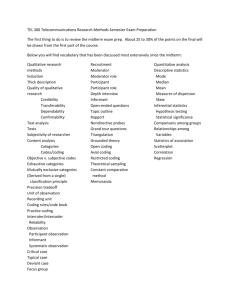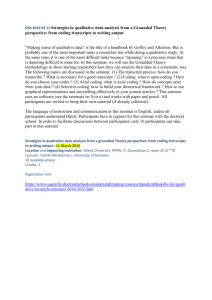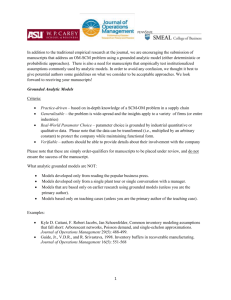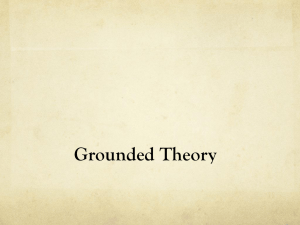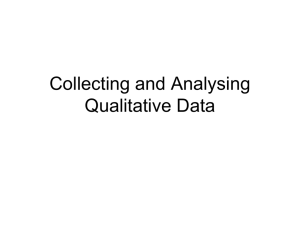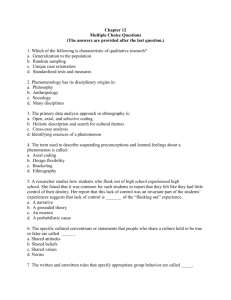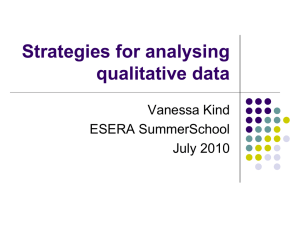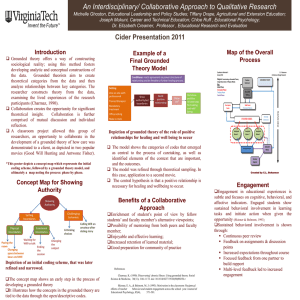Data Analysis, Interpretation, and Reporting
advertisement
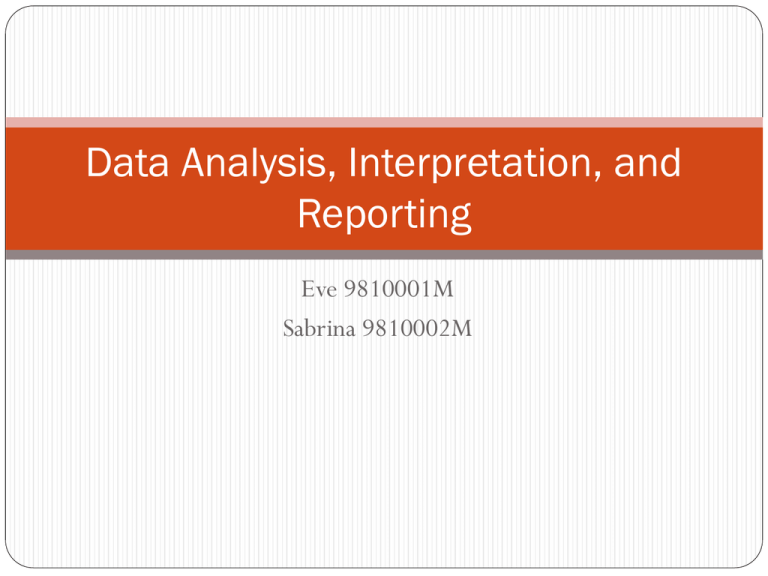
Data Analysis, Interpretation, and Reporting Eve 9810001M Sabrina 9810002M Outline Data Analytic Strategies Six Steps in Qualitative Data Analysis Grounded Theory Analysis Strategies Interpretation Issues in Qualitative Data Analysis Writing Research Reports Ways of Conducting Reports Data Analytic Strategies Recursive analytic strategies: analyze cases generate findings draw conclusion from grounded theory write report Nine qualitative data analysis principles: 1. Collect the data in the field and study all the data carefully to find out similarities and difference, concepts and reflection. 2. The data analysis can be stopped only with the emergence of regularities (Saturation and sufficiency of information). 3. Accountability of information: Keep notes or transcripts if readers or reviewers want to review the data analysis procedures and results. 4. Divide the data into smaller , more meaning units related to your major points after reading them all. 5. Organize the smaller units into categories (based on major points). The process is inductive. 6. Use comparison to build and refine categories, define conceptual similarities, find negative evidence, and discover patterns. Ex: pro one pattern con one pattern 7. The categories are flexible and are modified as further data analysis occurs. 8. Analyze negative cases to reflect their perspectives. 9. Synthesize the patterns into the grounded theory. Code Code Code Code Code Code Code (A) (B) (C) (B) (B) (C) (C) Categor1 (pro 1) Category 2 (pro2) Category 3 (pro3) Category 4 (con1) Pattern 2 Pattern 1 Grounded Theory Suggestions Should be: - connected with what is being discussed in points. - exact excerpt used in the statement. Should not be: - based on interviewer’s personal opinions. - irrelevant to the major points. the major Six Steps in Qualitative Data Analysis 1. Give codes from the notes. 2. Note personal reflections in the margin. 3. Sort and sift the notes to identify similar and different relationships between patterns. 4. Identify these patterns, similarities and differences. 5. Elaborate a small set of generalizations that cover the consistencies. 6. Examine those generalizations and form grounded theory. Grounded Theory Analysis Strategies Grounded theory: A process of constructing various data Inductive process by collecting, analyzing and comparing data systematically. Theory is grounded on data to explain the phenomena. The main purpose is to develop theory through understanding concepts that are related by means of statements of relationships. Recur by moving back and forth with the data, analyzing, collecting more data and analyzing some more until reaching conclusions. An interactional method of theory building by comparing and analyzing the data. Three steps in the grounded theory analytic process: 1. Open coding: Break data into small parts differences compare for similarities and explain the meanings of the data by focusing on “ who, when, where, what, how much, why” (ask questions to get a clear story) 2. Axial coding: After open coding, make connection (sort) between categories and confirm or disconfirm your hypotheses. 3. Selective coding: Select the core category (match hypotheses) and explain the minor category (against hypotheses) with additional supporting data. Coding process: Open coding Axial coding Select coding Interpretation Issues in Qualitative Data Analysis A. Triangulating Data Use multiple methods and data sources to support the strength of interpretations and conclusion Ex) semi-structured interviews, consent form, grounded theory B. Audits Questions to examine the data for interpretations and conclusion 1. Is sampling appropriate to ground the findings? 2. Are coding strategies applied correctly? 3. Is the category process appropriate? 4. Do the results link hypotheses? (examine literature review) 5. Are the negative cases explained? (minority’s voice) Suggestions Four steps of negative case testing 1. Make a rough hypothesis 2. Conduct a thorough search 3. Discard or reformulate hypothesis 4. Examine all relevant cases C. Cultural bias Discuss cultural differences with different groups of participants To see whether divergence is based on culturally different interpretations D. Generalization Not appropriate for qualitative research Two perspectives for generalization 1. Case-to-case translation (transferability)by providing thick description to apply to another setting 2. Analytic generalizationform a particular set of results to a broader theory Ex) use deviant cases Writing Research Reports A. Introduction B. Literature Review C. Methodology D. Results: Tie the results to study purpose (hypotheses) E. Discussions and Conclusion: Tie discussions to the literature; recommendations for practice; limitations of the study Ways of Conducting Reports A. Quantitative reports Report results by the use of tables and graphs Avoid first-person pronoun Use passive voice (It is shown / suggested that…) B. Qualitative reports Look for a deep and valid description (narrative style) Look for well-grounded theory Seek contextual meaning by understanding demographic information (different experiences) Thank you for your attention.
